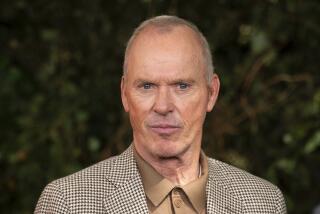In Buster Keaton’s Silence, Echoes of Historic L.A.
Little speaks more to Los Angeles’ ambivalent relationship with its past than its record on historic preservation--even when it comes to Hollywood legends like silent film star Buster Keaton.
Most of Keaton’s silent movie classics were made in the early 1900s. And so little remains of his old Hollywood locations that they might have been built during the Holy Roman Empire.
One of Keaton’s favorite exteriors has been usurped by a Jack in the Box. The fire station he used for chase scenes and sight gags has morphed into a forgettable beige office building whose reflective windows wink shamelessly at a Scientology marquee.
A bronze plaque marking the site of Keaton’s film studio off Cahuenga Boulevard was finally set in the sidewalk in the 1980s--on the wrong corner.
So when John Bengtson began a pilgrimage to Keaton’s locations, he was forced to become something of a cinematic archeologist.
Armed with just a few clues--building vents, architectural trim and the letters of signs--Bengtson spent four years searching through alleyways, raiding old insurance records and poring over business registries for pieces of the puzzle that was once the cityscape of Keaton Americana.
Aerial photos of the locations helped. So did Keaton’s widow, although she did not live to see the publication of his historical resurrection, “Silent Echoes: Discovering Early Hollywood Through the Films of Buster Keaton”
(https://www.SilentEchoes.net).
But for Bengtson, a bespectacled San Franciscan with an academic air, walking in the rediscovered steps of the Keaton myth is something akin to finding the Holy Grail.
“If there’s a . . . ground zero, it’s this block,” he says, gesturing to a stretch of Cahuenga between Sunset and Hollywood boulevards that is being repaved.
The construction has cut the street in half, slowing traffic to a crawl. The choking stench of hot asphalt fills the air. A cauterizing sun beats down pitilessly.
Bengtson is unfazed.
He picks his way through a rubble-strewn alley at Cosmo Street and Selma Avenue where a place called the Opium Den advertises “a ho-lotta porn.” A homeless man’s clothes are draped over the curb.
“People don’t realize they’re walking by famous settings from silent films,” he says, his eyes shining with the transcendent light of a very different vision.
He is imagining Keaton--known for his physical stunts and deadpan style--careening around the corner in a big black car in a scene from “Cops.”
“Virtually nothing has changed for 70 years,” Bengtson says, gazing down the alley and seeing a gem of architectural integrity. “For Hollywood, that’s pretty good.”
A less fortuitous fate befell the place, across from the Catalina Bar and Grill, where Keaton was whisked away on the running board of a passenger car in “Cops.”
A lyrical rust-red stone firehouse straight out of an Edward Hopper painting once dominated the scene’s backdrop. In its place sits a 1970s vintage beige high-rise that is as dull as a toaster.
Bengtson dismisses the nouveau urban dreck with a wave of his hand, as if it were a mirage.
“Some of these vintage photos are really like a time machine,” he says. “You can stand here and really imagine what it looked like then.”
One Keaton backdrop that is still standing is an older brick storefront now occupied by Custom Mosaic Design, at Sunset and Cahuenga boulevards. This was Bengtson’s Rosetta Stone.
Bengtson did his detective work with a scene in “Daydreams” in which Keaton whizzes by this building. He could make out only a few letters from the building next door. Using World War I-era business records, he determined that the site--the one now graced by a Jack in the Box--was once the Hollywood Laundry. A nearby strip mall with a Salvadoran pupuseria marks the place where Keaton once filmed in front of a quaint Japanese tea and herbs store.
“Why did they tear all of these down?” asks Bengtson’s Santa Monica Press publisher, Jeffrey Goldman, of no one in particular. “It’s so sad.”
Yet so typical. Most of the great architectural works from the early days of Los Angeles that have survived the city’s restless march into the future are private homes--the city’s richest lasting architectural treasures.
Public buildings, sheltered by paper-thin preservation laws that are a developer’s dream, have been largely neglected or shrugged off by the city that invented reinvention.
But for Bengtson, locating even the last dregs of Keaton’s gritty pre-modern urban world has been a triumph.
He still recalls the thrill he felt five years ago when he met Keaton’s widow, Eleanor Keaton, at the Orpheum during a silent film festival screening of Keaton’s “The General.”
Bengtson and Eleanor became good friends, and she was a big supporter of his book project. He is still disappointed that Eleanor, a former MGM dancer, died of lung cancer in October 1998, before his book was finished.
Buster Keaton also died of lung cancer, in 1966.
So it is Bengtson who speaks to Keaton’s memory. He was visibly moved during a recent presentation to an audience of silent film fans in San Francisco.
“Five years ago I was in the audience, and there I was up on the stage,” Bengtson said. “It’s been amazing to come this far.”
More to Read
The biggest entertainment stories
Get our big stories about Hollywood, film, television, music, arts, culture and more right in your inbox as soon as they publish.
You may occasionally receive promotional content from the Los Angeles Times.










